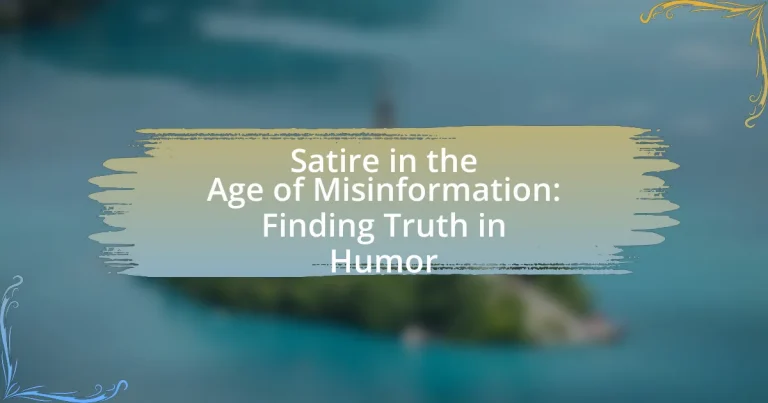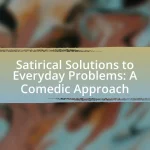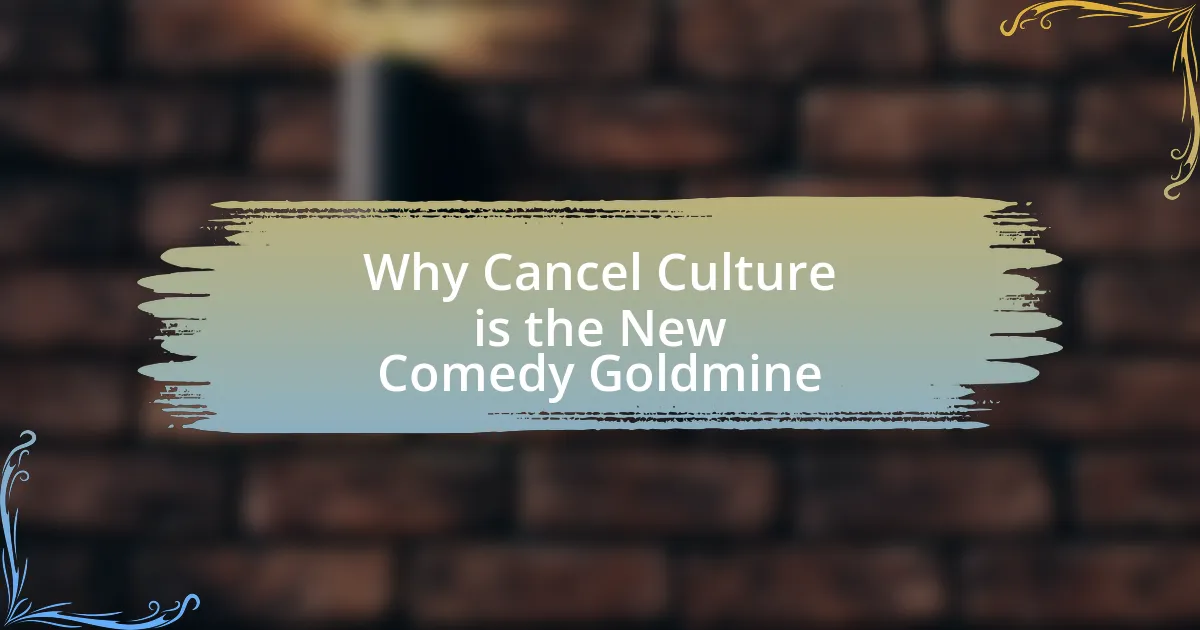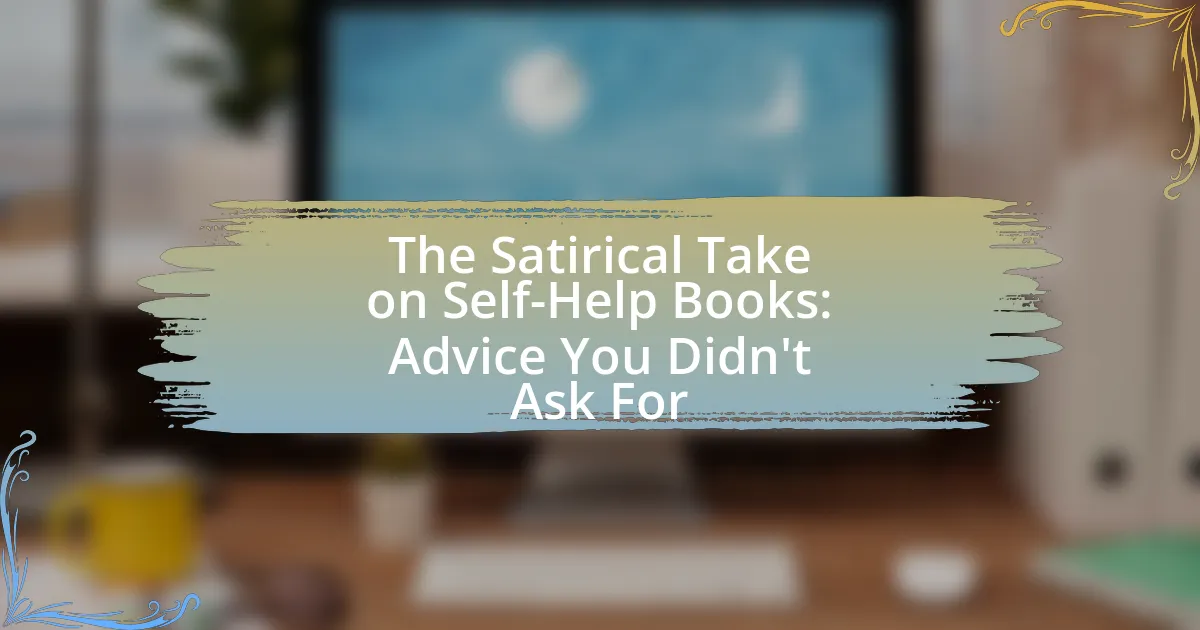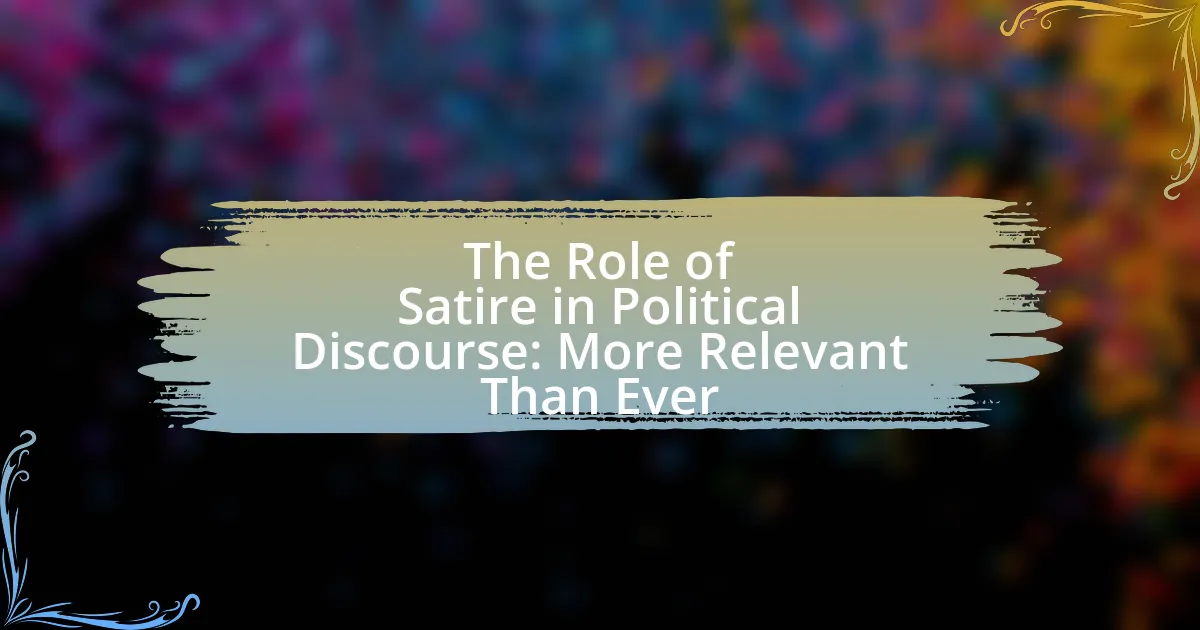Satire in the age of misinformation serves as a critical tool for humorously critiquing societal issues, particularly the spread of false information. This article explores how satire functions as a mechanism for truth, its historical roots, and its evolution with digital media. It highlights the importance of satire in contemporary discourse, its role in shaping public opinion, and the techniques used by satirists to engage audiences. Additionally, the article addresses the risks associated with satire, including misinterpretation and the challenges faced in a polarized media landscape, while offering practical tips for aspiring satirists to effectively combat misinformation.
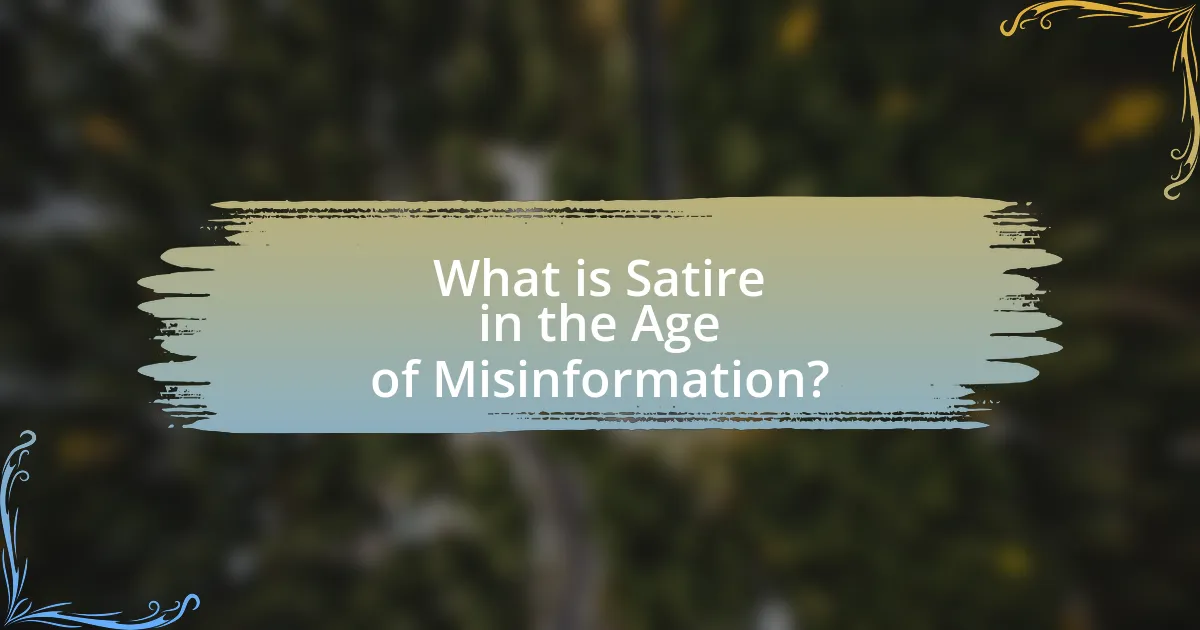
What is Satire in the Age of Misinformation?
Satire in the age of misinformation is a form of humor that critiques societal issues, particularly the spread of false information. It serves as a tool to expose the absurdities and contradictions in public discourse, often highlighting the dangers of believing and disseminating unverified claims. For example, satirical programs like “The Daily Show” and “Saturday Night Live” use humor to address political and social issues, effectively engaging audiences while encouraging critical thinking about the information they consume. This approach is crucial in a landscape where misinformation can easily spread, as satire can prompt audiences to question the validity of the narratives presented to them.
How does satire function as a tool for truth in a misleading environment?
Satire functions as a tool for truth in a misleading environment by using humor and exaggeration to expose and critique societal issues, thereby revealing underlying truths. This form of expression allows audiences to confront uncomfortable realities in a more palatable way, making complex topics accessible and engaging. For instance, satirical programs like “The Daily Show” and “Saturday Night Live” often highlight political hypocrisy and misinformation, prompting viewers to question the narratives presented by traditional media. Research indicates that satire can enhance critical thinking and awareness, as it encourages audiences to analyze information critically rather than accept it at face value.
What are the historical roots of satire in relation to misinformation?
The historical roots of satire in relation to misinformation can be traced back to ancient civilizations, where satire served as a tool for social critique and commentary on political and societal issues. For instance, in ancient Greece, playwrights like Aristophanes used comedic plays to expose the absurdities of political figures and societal norms, often highlighting misinformation propagated by those in power. Similarly, during the Roman Empire, satirists like Juvenal and Horace critiqued corruption and moral decay, using humor to reveal truths obscured by false narratives. This tradition continued through the Middle Ages and into the Renaissance, where satire became a means to challenge authority and question the veracity of information disseminated by the elite. The use of satire to address misinformation has persisted into modern times, as seen in the works of Jonathan Swift and Mark Twain, who employed humor to critique societal issues and expose falsehoods. Thus, satire has historically functioned as a vital mechanism for confronting misinformation and promoting critical thinking.
How has the definition of satire evolved with the rise of digital media?
The definition of satire has evolved to encompass a broader range of formats and platforms due to the rise of digital media. Traditionally, satire was primarily found in literature and theater, but with the advent of the internet and social media, it has expanded to include memes, videos, and online articles, allowing for rapid dissemination and immediate audience engagement. This shift has led to a more participatory form of satire, where users can create and share their own satirical content, often blurring the lines between satire and misinformation. For instance, platforms like Twitter and TikTok have enabled satirical commentary to reach wider audiences quickly, influencing public discourse in real-time. The accessibility of digital media has also resulted in a democratization of satire, where anyone can contribute, thus altering its traditional gatekeeping roles.
Why is satire important in contemporary discourse?
Satire is important in contemporary discourse because it serves as a critical tool for social commentary and political critique. By using humor and exaggeration, satire can highlight societal issues, challenge authority, and provoke thought in ways that traditional discourse may not achieve. For instance, satirical programs like “The Daily Show” and “Saturday Night Live” have effectively brought attention to political corruption and social injustices, influencing public opinion and encouraging civic engagement. Research indicates that satire can enhance understanding of complex issues, as it simplifies and distills information, making it more accessible to a broader audience. This role is particularly vital in an age of misinformation, where satire can help audiences discern truth from falsehood by framing serious topics in a relatable manner.
What role does satire play in shaping public opinion?
Satire plays a significant role in shaping public opinion by critiquing societal norms and political issues through humor, which can make complex topics more accessible. This form of expression often highlights contradictions and absurdities in public discourse, prompting audiences to reconsider their views. For instance, studies have shown that satirical content, such as that produced by programs like “The Daily Show,” can increase political awareness and engagement among viewers, particularly among younger demographics. Research by the Pew Research Center indicates that individuals who consume satirical news are more likely to discuss political issues and seek out additional information, thereby influencing public opinion and fostering critical thinking.
How can satire challenge authority and expose falsehoods?
Satire can challenge authority and expose falsehoods by using humor and irony to critique and highlight the absurdities of those in power. This form of expression allows satirists to address serious issues in a way that is accessible and engaging, often making the audience more receptive to the underlying truths. For instance, political cartoons and satirical news shows like “The Daily Show” have historically pointed out inconsistencies and lies from political leaders, prompting public discourse and scrutiny. By exaggerating the flaws and contradictions of authority figures, satire encourages critical thinking and can lead to greater accountability.
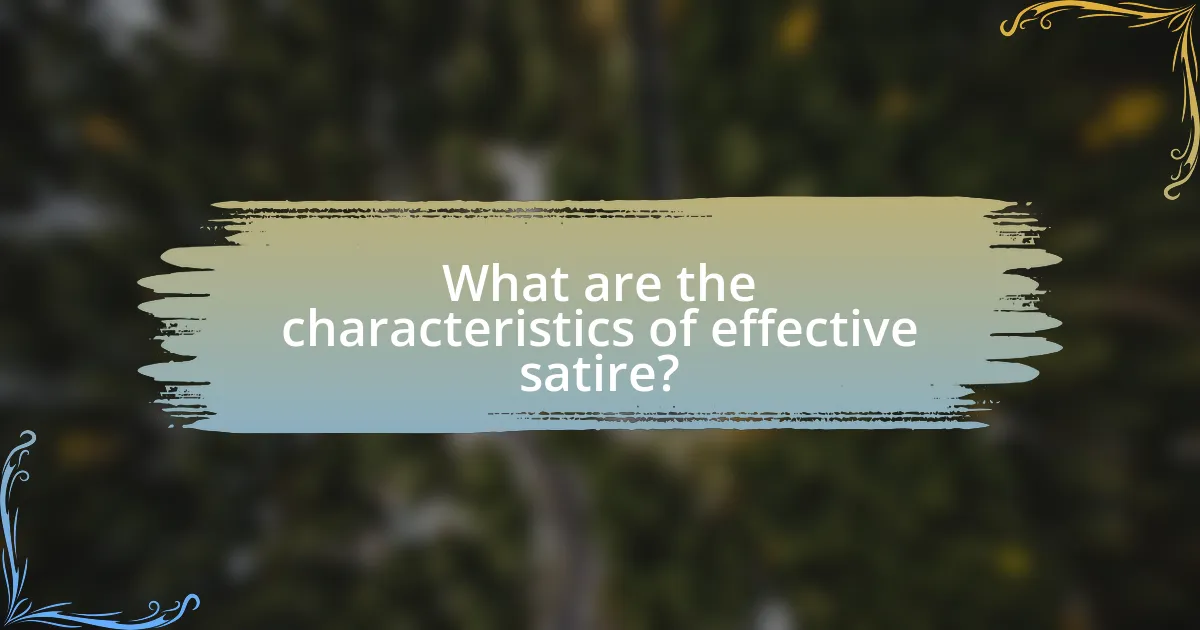
What are the characteristics of effective satire?
Effective satire is characterized by its ability to use humor, irony, and exaggeration to critique societal norms, political issues, or cultural phenomena. This form of expression often employs wit to provoke thought and encourage reflection on the subject matter. For instance, successful satirical works like Jonathan Swift’s “A Modest Proposal” utilize hyperbole to highlight the absurdity of social injustices, thereby prompting audiences to reconsider their perspectives. Additionally, effective satire often relies on a clear target, ensuring that the audience understands the context and implications of the critique, which enhances its impact and relevance in discussions about misinformation and truth.
How does humor enhance the impact of satire?
Humor enhances the impact of satire by making critical commentary more accessible and engaging to audiences. When humor is employed, it disarms the audience, allowing them to confront uncomfortable truths without feeling defensive. For instance, studies show that humorous satire can increase audience retention of the message, as seen in programs like “The Daily Show,” which effectively use comedy to highlight political issues. This combination of humor and satire not only entertains but also encourages reflection and discussion on serious topics, thereby amplifying the overall message and its societal relevance.
What techniques do satirists use to engage their audience?
Satirists engage their audience through techniques such as exaggeration, irony, and parody. Exaggeration amplifies certain traits or behaviors to highlight absurdities, making the audience reflect on real issues; for example, political cartoons often depict politicians with exaggerated features to critique their actions. Irony contrasts expectations with reality, prompting audiences to recognize the discrepancies in societal norms or behaviors, as seen in satirical news shows that present serious topics in a humorous light. Parody imitates the style of a particular genre or work, allowing audiences to appreciate the original while critiquing its flaws, evident in films that mock popular culture. These techniques effectively draw attention to societal issues, encouraging critical thinking and engagement among viewers.
How does timing influence the effectiveness of satirical content?
Timing significantly influences the effectiveness of satirical content by determining its relevance and impact on the audience. When satirical material is released in close proximity to the events it critiques, it resonates more strongly with the audience, as seen in the rapid response of satirical shows like “Saturday Night Live” to political events, which often leads to increased viewer engagement and social media sharing. Research indicates that timely satire can enhance audience understanding of complex issues, as it frames current events in a humorous context that is easier to digest, thereby fostering critical thinking. For example, during the COVID-19 pandemic, timely satire addressing misinformation about the virus helped clarify public health messages, demonstrating that the effectiveness of satire is closely tied to its timing in relation to ongoing societal conversations.
What are the risks associated with satire in the age of misinformation?
The risks associated with satire in the age of misinformation include the potential for misinterpretation and the spread of false narratives. Satire, while intended to critique or highlight absurdities, can be misconstrued by audiences who may not recognize it as humor, leading to the acceptance of satirical content as factual. A study by the Pew Research Center found that 64% of Americans believe that satire can be mistaken for real news, which underscores the danger of audiences taking satirical statements literally. Additionally, the rapid dissemination of information through social media amplifies these risks, as satirical content can go viral, further blurring the lines between fact and fiction.
How can satire be misinterpreted or taken out of context?
Satire can be misinterpreted or taken out of context when audiences lack the necessary background knowledge or fail to recognize the intended humor, leading to a misunderstanding of the satirical message. For example, a satirical piece that exaggerates a political stance may be perceived as a genuine endorsement of that stance by individuals who do not grasp the underlying irony. This misinterpretation can be exacerbated by the rapid spread of information on social media, where snippets of satire are often shared without the full context, resulting in distorted perceptions. Research indicates that 59% of social media users have encountered misinformation, which can include misread satirical content, highlighting the challenges in discerning humor from reality in a digital landscape.
What ethical considerations should satirists keep in mind?
Satirists should prioritize accuracy, respect, and social responsibility in their work. Accuracy ensures that the satire does not misrepresent facts or spread misinformation, which is crucial in an era where misinformation is rampant. Respect involves being mindful of the potential harm that satire can cause to individuals or marginalized groups, avoiding perpetuating stereotypes or inciting hatred. Social responsibility requires satirists to consider the broader impact of their work on public discourse, aiming to provoke thought and discussion rather than simply entertain. These ethical considerations are essential for maintaining credibility and fostering a constructive dialogue in society.
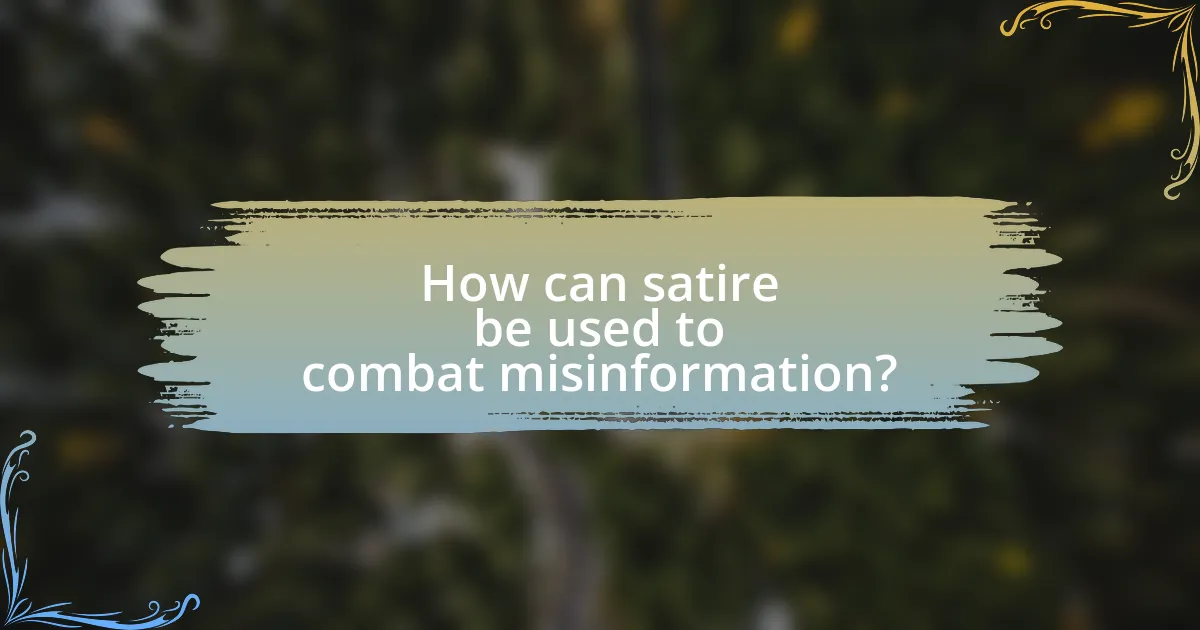
How can satire be used to combat misinformation?
Satire can be used to combat misinformation by highlighting absurdities and inconsistencies in false narratives, thereby encouraging critical thinking among audiences. By exaggerating the flaws in misleading information, satire makes it easier for individuals to recognize and question the validity of such claims. For instance, satirical news outlets like The Onion and The Borowitz Report often use humor to expose the ridiculousness of real-world events and statements, prompting readers to reflect on the truth behind the headlines. This approach not only entertains but also serves as a tool for education, fostering media literacy and skepticism towards unverified information.
What strategies can satirists employ to promote critical thinking?
Satirists can promote critical thinking by using exaggeration, irony, and humor to highlight societal issues and provoke reflection. By presenting absurd scenarios that mirror real-life situations, satirists encourage audiences to question the status quo and analyze the underlying truths. For instance, shows like “Saturday Night Live” and “The Daily Show” often employ satire to critique political figures and policies, prompting viewers to think critically about current events. Research indicates that exposure to satirical content can enhance media literacy, as it requires audiences to discern fact from fiction and engage with complex ideas.
How can satire encourage audiences to question sources of information?
Satire encourages audiences to question sources of information by highlighting absurdities and inconsistencies in narratives presented by those sources. Through humor and exaggeration, satire exposes the flaws in arguments and the biases of media outlets, prompting viewers to critically analyze the credibility of the information they consume. For instance, satirical programs like “The Daily Show” and “Saturday Night Live” often parody news segments, revealing how sensationalism can distort facts. This approach not only entertains but also fosters skepticism, encouraging audiences to seek out reliable information and verify claims before accepting them as truth.
What examples exist of successful satirical campaigns against misinformation?
Successful satirical campaigns against misinformation include “The Onion’s” satirical articles that parody real news, effectively highlighting the absurdity of false claims. For instance, during the 2016 U.S. presidential election, “The Onion” published pieces that mocked the spread of fake news, drawing attention to the issue and encouraging critical thinking among readers. Another example is the “Fact-Check This” campaign by the Australian Broadcasting Corporation, which used humor to debunk viral misinformation on social media, leading to increased public awareness about the importance of verifying information. These campaigns demonstrate how satire can effectively engage audiences and promote media literacy.
What are the limitations of satire in addressing misinformation?
Satire has limitations in effectively addressing misinformation due to its reliance on humor, which can lead to misinterpretation. Audiences may not grasp the satirical intent, resulting in confusion rather than clarity. Additionally, satire often targets specific issues or individuals, which can alienate segments of the audience who may not find the humor relatable or who may dismiss the underlying message. Research indicates that while satire can raise awareness, it may also reinforce existing biases, as individuals often interpret satirical content through their own ideological lenses. This duality can hinder its potential to foster critical thinking about misinformation.
How does audience perception affect the reception of satirical content?
Audience perception significantly influences the reception of satirical content by determining how humor is interpreted and whether the intended message is understood. When audiences possess a strong understanding of the context or subject matter being satirized, they are more likely to appreciate the humor and critique embedded within the satire. Conversely, if the audience lacks familiarity or holds differing beliefs, they may misinterpret the satire, leading to confusion or offense. Research indicates that individuals with higher media literacy are better equipped to recognize and appreciate satire, as evidenced by a study published in the Journal of Communication, which found that media-savvy individuals are more likely to engage with satirical content critically and recognize its underlying messages. Thus, audience perception shapes the effectiveness and impact of satire in conveying truth amidst misinformation.
What challenges do satirists face in a polarized media landscape?
Satirists face significant challenges in a polarized media landscape, primarily due to the risk of misinterpretation and backlash from audiences with divergent political views. In such an environment, satire can easily be perceived as partisan, alienating segments of the audience rather than fostering critical dialogue. A study by the Pew Research Center in 2020 found that 62% of Americans believe that news organizations favor one side of the political spectrum, which complicates satirists’ efforts to engage a broad audience. Additionally, the prevalence of misinformation can undermine the effectiveness of satire, as audiences may struggle to discern the intended humor from the actual facts, leading to confusion and reinforcing existing biases.
What practical tips can enhance the effectiveness of satire in today’s media?
To enhance the effectiveness of satire in today’s media, creators should focus on clarity, relevance, and audience engagement. Clarity ensures that the satirical message is easily understood, allowing the audience to grasp the underlying truth being conveyed. Relevance involves addressing current events or societal issues that resonate with the audience, making the satire more impactful. Engaging the audience through interactive elements, such as social media discussions or live performances, fosters a deeper connection and encourages critical thinking. Research indicates that effective satire can lead to increased awareness and understanding of complex issues, as seen in studies analyzing the impact of satirical news programs on public opinion.
How can aspiring satirists refine their craft to address misinformation effectively?
Aspiring satirists can refine their craft to address misinformation effectively by honing their ability to analyze and deconstruct false narratives. This involves studying various forms of misinformation, understanding the techniques used to spread it, and identifying the emotional triggers that resonate with audiences. For instance, satirists can utilize fact-checking resources and credible data to create content that highlights the absurdity of misinformation, thereby educating their audience while entertaining them. Research indicates that humor can enhance message retention; a study published in the journal “Psychological Science” found that humorous content is more likely to be remembered and shared, making it a powerful tool for combating falsehoods. By combining sharp wit with factual accuracy, aspiring satirists can effectively challenge misinformation and promote critical thinking among their audience.
What resources are available for understanding the nuances of satire?
Resources available for understanding the nuances of satire include academic texts, online courses, and critical essays. Notable academic texts such as “Satire: A Critical Reintroduction” by David J. Rothman provide foundational insights into the mechanics and history of satire. Online platforms like Coursera and edX offer courses on satire that explore its role in society and media. Additionally, critical essays published in journals like “The Journal of Popular Culture” analyze contemporary examples of satire, illustrating its complexities and effectiveness in conveying truth amidst misinformation. These resources collectively enhance comprehension of satire’s multifaceted nature.
